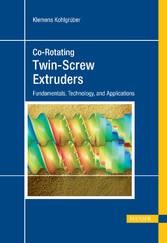Search and Find
Service
Preface
6
Contents
8
1 Introduction
16
2 Historical Development of Co-RotatingTwin Screw Extruders
24
2.1 Introduction
24
2.2 Early Developments
24
2.3 Pioneering Period
35
2.4 New High Viscosity Technology with Co-RotatingExtruders
38
2.5 Special Developments from Bayer-Hochviskostechnik(High Viscosity Technology Group)
42
2.6 Developments after Licensing
44
2.7 Developments after Expiration of the Primary Patents
47
3 Rheological Properties of Polymer Melts
50
3.1 Introduction and Motivation
50
3.2 Classification of Rheological Behavior of Solidsand Fluids
50
3.3 Comparison of Viscous Fluid and Viscoelastic Fluid
55
3.4 Temperature Dependence of Shear Viscosity
59
3.5 Influence of Molecular Parameters on RheologicalProperties of Polymer Melts
62
3.6 Shear Flows
64
3.7 Extensional Flows
67
4 General Overview of the CompoundingProcess: Tasks, Selected Applications,and Process Zones
72
4.1 Compounding Tasks and Requirements
72
4.2 Tasks and Design of the Processing Zones of aCompounding Extruder
74
4.3 Characteristic Process Parameters
87
4.4 Process Examples
91
4.5 Technical Trends in Compounding
99
4.6 Symbols and Abbreviations
103
5 Geometry of the Co-Rotating Extruders:Conveying, and Kneading Elements
106
5.1 Introduction
106
5.2 The Fully Wiped Profile from Arcs
107
5.3 Geometric Design of Closely Intermeshing Profiles
109
5.4 Dimensions of Screw Elements with Clearances
110
5.5 Transition between Different Numbers of Threads
113
5.6 Calculation of a Screw Profile for Production Accordingto Planar Offset
114
5.7 Conveying Characteristics of Different Geometries
116
5.8 Kneading Elements
117
6 Modeling: Possibilities and Limitations
120
6.1 The Motivation for Modeling
120
6.2 Screw Design
121
6.3 Modeling Approaches
122
6.4 Model Dimensions
123
6.5 Extruder: 0-Dimensional
125
6.6 Extruder: 2-Dimensional
128
6.7 Extruder: 1-Dimensional
129
6.8 Extruder: 3-Dimensional
132
6.9 Simulation: Possibilities and Limitations
135
7 Pressure Generation and Energy Input inthe Melt
136
7.1 Operating Conditions of Conveying Screw Elements
136
7.2 Illustration of Dimensionless Groups
138
7.3 Calculation of the Back-Pressure Length
143
7.4 Efficiency during Pressure Generation
144
7.5 Example for the Design of a Pressure Build-Up Zone
145
7.6 Pressure and Energy behavior with Shear Thinning
146
8 Computational Fluid Dynamics
154
8.1 Why Computational Fluid Dynamics?
154
8.2 Workflow of a Computational Fluid Dynamics Process
155
8.3 Computational Examples
157
8.4 Conclusion and Outlook
171
9 Mixing and Dispersing: Principles
174
9.1 Introduction
174
9.2 Distributive Mixing
174
9.3 Dispersive Mixing
182
9.4 Determining the Mixing Quality
188
10 Degassing Polymer Melts with Co-RotatingTwin Screw Extruders
196
10.1 Requirements for Degassing
196
10.2 Function-Specific Design
198
10.3 Process Limits
208
10.4 Scale-Up
209
10.5 Process Examples
209
10.6 Conclusion
216
11 Simulation or Scale-Up –Alternatives for Extruder Layout?
218
11.1 Process Sections of the Compounding Extruder
218
11.2 Computation Possibilities for Discharge Parts
225
11.3 Scale-Up
226
12 Screw Elements for Co-rotating, CloselyIntermeshing, Twin-Screw Extruders
230
12.1 Design of the Screw Element
230
12.2 Combining Screw Elements
233
12.3 Screw Elements and How They Work
235
13 Overview of Patented Screw Elements
252
14 The ZSK Series and Applications in theChemical Industry and for Renewable RawMaterials
276
14.1 Development of High Torques, Volumesand Screw Speeds
276
14.2 Torque-Limited and Volume-Limited Throughputs
281
14.3 Process-Dependent Energy Requirement
283
14.4 Chemical and Pharmaceutical Applications
287
14.5 Applications for Renewable Raw Materials in thePlastic and Food Sectors
296
15 ZSK-NT the New Two-Stage ProcessingSystem for High Throughputs
304
15.1 Current Requirements for the Processing of Polyolefins
304
15.2 Two-stage Large-Scale Plants for the Processing ofBimodal Polyethylene
305
15.3 Quality Assessments for Bimodal Pipes
306
15.4 ZSK-NT Compared with Standard Technology
307
15.5 Design of Pressure Build-Up Zones
310
15.7 Outlook
315
15.8 Notation
315
16 Material Selection for Twin Screw ExtruderComponents in Contact with Resin
318
16.1 Introduction
318
16.2 What is Wear?
318
16.3 Wear in Operating Experience
319
16.4 Choice of Materials for Extruder Barrel and ScrewElements
322
17 Drive Units for Co-Rotating Twin-ScrewExtruders
330
17.1 Introduction
330
17.2 Drive Units for Small- to Medium-Size Co-RotatingTwin-Screw Extruders
330
17.3 Drive Units for Large Co-Rotating Extruders
347
17.4 Safety Clutches
355
17.5 Gearbox
357
Index
364
All prices incl. VAT












